Ottawa
Illinois, United States
city, seat (1831) of La Salle county, north-central Illinois, U.S. It lies at the confluence of the Fox and Illinois (Illinois River) rivers, about 80 miles (130 km) southwest of Chicago. The site was inhabited by Illinois Indians when it was visited by French explorers Jacques Marquette (Marquette, Jacques) and Louis Jolliet (Jolliet, Louis) in 1673. René-Robert Cavelier, sieur (lord) de La Salle (La Salle, René-Robert Cavelier, sieur (lord) de), built a fort nearby in 1682. The town was laid out in 1830; its name derives from a Native American word meaning “to trade.” In 1834 Norwegian immigrants began arriving, and two years later the start of construction on the Illinois and Michigan Canal (opened 1848) brought Irish immigrants to the area and contributed to the city's growth. The first of the seven Lincoln-Douglas debates was held in Ottawa in August 1858. Coal mining was important until the 1920s.
Ottawa is situated in a rich agricultural area (primarily corn 【maize】 and soybeans). Manufactures include plastics, glass, and automotive parts. Silica sand is also produced. The city features a memorial dedicated to W.D. Boyce, founder of the Boy Scouts of America, and a scouting museum. Illini, Buffalo Rock, Starved Rock, and Matthiessen state parks and LaSalle Lake State Fish and Wildlife Area are nearby. Ottawa lies along the Illinois and Michigan Canal State Trail and is part of the Illinois and Michigan Canal National Heritage Corridor. Inc. village, 1837; city, 1853. Pop. (1990) 17,451; (2000) 18,307.
Kansas, United States
city, seat (1864) of Franklin county, eastern Kansas, U.S. It lies on the Marais des Cygnes River. Ottawa was founded in 1864 near the Ottawa Indian Baptist Mission, which had been established in 1837 on lands given (1832) to the Ottawa Indians in exchange for their Ohio lands. During the Border War the area served as a centre of abolitionist activity; proslavery militia burned a portion of the mission in 1857. When the Indians were moved to Oklahoma in 1867, settlers rushed to the site; prosperity followed construction of railroad machine shops in 1872.
A handsome, tree-lined city, Ottawa is now the trading centre for a grain, poultry, and livestock area; manufactures include textiles and plastic and metal products. A natural-gas field discovered in 1907 remains in production. Pomona State Park is west of the city. Inc. 1866. Pop. (1990) 10,667; (2000) 11,921.
Ontario, Canada
Introduction
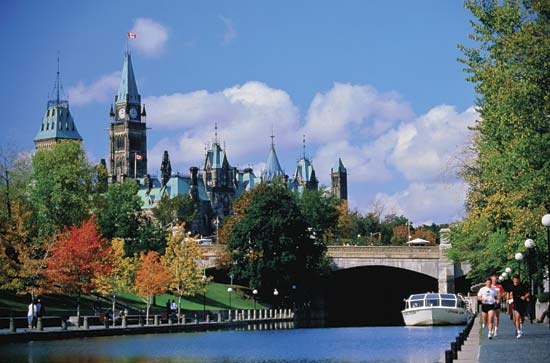 capital of Canada, southeastern Ontario. The central part of the city is located on a limestone bluff at the confluence of the Ottawa (Outaouais), Gatineau, and Rideau rivers; the northern terminus of the Rideau Canal (which largely follows the course of the Rideau River) is just southwest of that river's mouth. The city's climate is continental, with warm, humid summers and cold, usually snowy winters. Ottawa's metropolitan area lies astride the Ontario-Quebec border and includes (in Quebec) the city of Gatineau. Because of its location on the boundary between English-speaking Ontario and French-speaking Quebec and its position as national capital, Ottawa is one of the most bilingual cities in the country. Area metro. area, 1,820 square miles (4,715 square km). Pop. (2006) city, 812,129; metro. area, 1,130,761.
capital of Canada, southeastern Ontario. The central part of the city is located on a limestone bluff at the confluence of the Ottawa (Outaouais), Gatineau, and Rideau rivers; the northern terminus of the Rideau Canal (which largely follows the course of the Rideau River) is just southwest of that river's mouth. The city's climate is continental, with warm, humid summers and cold, usually snowy winters. Ottawa's metropolitan area lies astride the Ontario-Quebec border and includes (in Quebec) the city of Gatineau. Because of its location on the boundary between English-speaking Ontario and French-speaking Quebec and its position as national capital, Ottawa is one of the most bilingual cities in the country. Area metro. area, 1,820 square miles (4,715 square km). Pop. (2006) city, 812,129; metro. area, 1,130,761.History
The first descriptions of Ottawa's future site were written by the founder of New France, Samuel de Champlain, in 1613. The rivers served as passageways for explorers and traders over the following two centuries. The Napoleonic Wars increased Britain's need for shipbuilding timber, and the Ottawa River valley offered just such resources. In 1800 an American, Philemon Wright, had begun timbering across the Ottawa River in what became the city of Hull (now part of Gatineau). During the War of 1812 (1812, War of) between Britain and the United States, the Rideau provided the British with a safe shipping route from the Ottawa River to Kingston, on Lake Ontario, thus spurring settlement of Ottawa. It was hastened by the arrival in 1826 of Lieutenant Colonel John By (By, John) of the Royal Engineers to work on canalizing the river, and the town became Bytown.
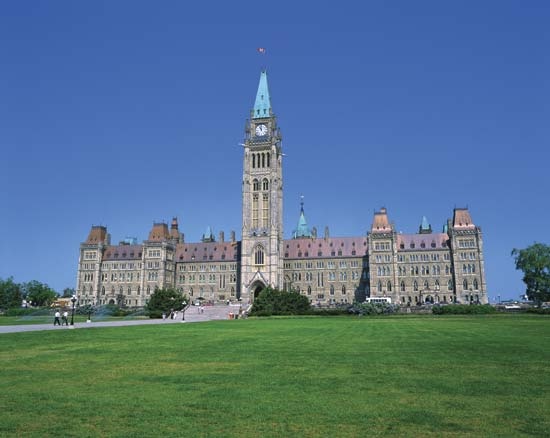 Ottawa might still be a modest city had not political quarrels between Quebec city and Toronto and between Montreal and Kingston induced leaders to call upon Queen Victoria to designate a capital for United Canada. In 1855 Bytown was incorporated and rechristened Ottawa, named for the Ottawa Indians. It became the fastest-growing metropolis in eastern Canada, a development due largely to the presence of the national government. Two major fires, in 1900 and 1916, did considerable damage to the city; the second fire destroyed much of the Parliament Buildings complex. Reconstruction soon began, and the central building was completed in 1922.
Ottawa might still be a modest city had not political quarrels between Quebec city and Toronto and between Montreal and Kingston induced leaders to call upon Queen Victoria to designate a capital for United Canada. In 1855 Bytown was incorporated and rechristened Ottawa, named for the Ottawa Indians. It became the fastest-growing metropolis in eastern Canada, a development due largely to the presence of the national government. Two major fires, in 1900 and 1916, did considerable damage to the city; the second fire destroyed much of the Parliament Buildings complex. Reconstruction soon began, and the central building was completed in 1922.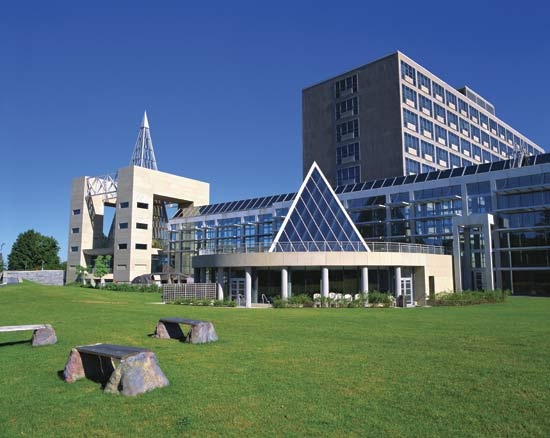 In 1937 Prime Minister William L. Mackenzie King brought the architect Jacques Gréber from France to begin the redevelopment of the national capital district. The plan that was devised included large areas of parkland in and around the federal government buildings and around the perimeter of the city. Ottawa's population continued to grow, reaching some 325,000 in the late 1990s. In 2001 the city merged administratively with its neighbouring communities, more than doubling its population.
In 1937 Prime Minister William L. Mackenzie King brought the architect Jacques Gréber from France to begin the redevelopment of the national capital district. The plan that was devised included large areas of parkland in and around the federal government buildings and around the perimeter of the city. Ottawa's population continued to grow, reaching some 325,000 in the late 1990s. In 2001 the city merged administratively with its neighbouring communities, more than doubling its population.The contemporary city
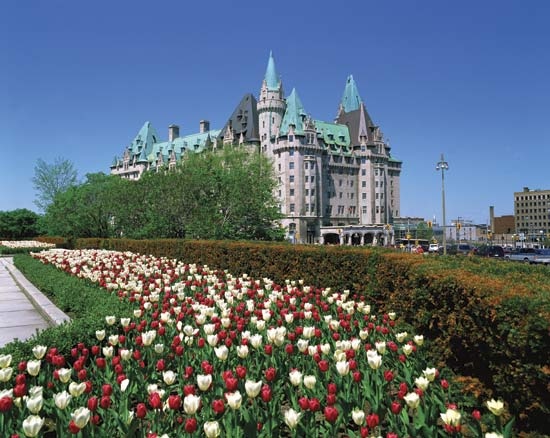 The fur trade and lumbering have diminished in favour of computer-related and other high-technology industries. Tourism and conventions are also major contributors to the economy. The federal government is the major employer. Many commercial and financial associations from around the country as well as embassies and trade associations are also located there.
The fur trade and lumbering have diminished in favour of computer-related and other high-technology industries. Tourism and conventions are also major contributors to the economy. The federal government is the major employer. Many commercial and financial associations from around the country as well as embassies and trade associations are also located there.Ottawa is served by both of Canada's major railroads and by several airlines. There is a good network of expressways and major roads in and around the metropolitan area. Regional mass transit is centred on a system of dedicated bus rapid-transit lines (i.e., lines that run on their own roadways); in addition, a light-rail line began operating in 2001. Navigation on the Ottawa and Rideau rivers, except for pleasure craft, is a thing of the past.
 The major cultural centres remain the city's three universities. The University of Ottawa (1865) and St. Paul University (1848) are bilingual institutions, whereas instruction at Carleton University (1942) is entirely in English. A large community college, Algonquin, provides technical training. Ottawa also houses the National Arts Centre, which includes an opera house and two theatres, the National Library and Public Archives Building, the National Museum of Science and Technology, and the National Gallery of Canada.
The major cultural centres remain the city's three universities. The University of Ottawa (1865) and St. Paul University (1848) are bilingual institutions, whereas instruction at Carleton University (1942) is entirely in English. A large community college, Algonquin, provides technical training. Ottawa also houses the National Arts Centre, which includes an opera house and two theatres, the National Library and Public Archives Building, the National Museum of Science and Technology, and the National Gallery of Canada.
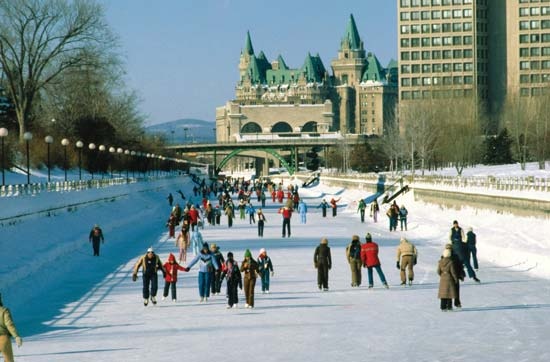 Ottawa contains large tracts of parkland within the city limits, and the National Capital Commission maintains the broad greenbelt around the city as well as the large Gatineau Park in Quebec. The Rideau Canal, now used for recreational purposes, was designated a UNESCO World Heritage site in 2007. Ottawa is home to the Senators of the National Hockey League. The city's annual Winterlude festival draws large crowds to a variety of cultural events and outdoor activities.
Ottawa contains large tracts of parkland within the city limits, and the National Capital Commission maintains the broad greenbelt around the city as well as the large Gatineau Park in Quebec. The Rideau Canal, now used for recreational purposes, was designated a UNESCO World Heritage site in 2007. Ottawa is home to the Senators of the National Hockey League. The city's annual Winterlude festival draws large crowds to a variety of cultural events and outdoor activities.people
Algonquian (Algonquian languages)-speaking North American Indians whose original territory focused on the Ottawa River, the French River, and Georgian Bay, in present northern Michigan, U.S., and southeastern Ontario and southwestern Quebec, Can. According to tradition, the Ottawa, Ojibwa, and Potawatomi were formerly one tribe, having migrated from the northwest and separated at what is now Mackinaw, Mich. The earliest known location of the Ottawa was on Manitoulin Island.
The Ottawa were widely known as traders; their location and negotiating skills enabled them to become middlemen in intertribal commerce. Their canoes traveled as far west as Green Bay, Wis., and as far east as Quebec to buy and sell such merchandise as cornmeal, furs, sunflower oil, mats, tobacco, and medicinal herbs. Before colonization by the French and English, the Ottawa were semisedentary, living in agricultural villages in summer and separating into family groups for winter hunts. Planting and harvesting crops were women's occupations; hunting and fishing were the responsibility of men. Ottawa villages were sometimes palisaded for protection.
In the late 17th century the tribe comprised four, or possibly five, major divisions, which were subdivided into local bands; they are believed to have had several clans distributed among the bands. Attacked by the Iroquois, the Ottawa fled, some joining the Potawatomi at Green Bay, others dispersing throughout the Lower Peninsula of Michigan, Wisconsin, and northern Illinois.
Early 21st-century population estimates indicated some 14,000 individuals of Ottawa descent.
- Dorsey, George A.
- Dorsey, James Owen
- Dorsey, Jimmy
- Dorsey, Thomas Andrew
- Dorsey, Tommy
- Dorsten
- Dorst, Tankred
- Dortmund
- Dortmund-Ems Canal
- Dort, Synod of
- Dorval
- dory
- Doré, Gustave
- Dos Hermanas
- dosimeter
- Dos Passos, John
- Dos Pilas
- dos Santos, José
- Dosso
- Dosso Dossi
- Dostoyevsky, Fyodor
- Dosítheos
- Dothan
- Dotremont, Christian
- dotterel